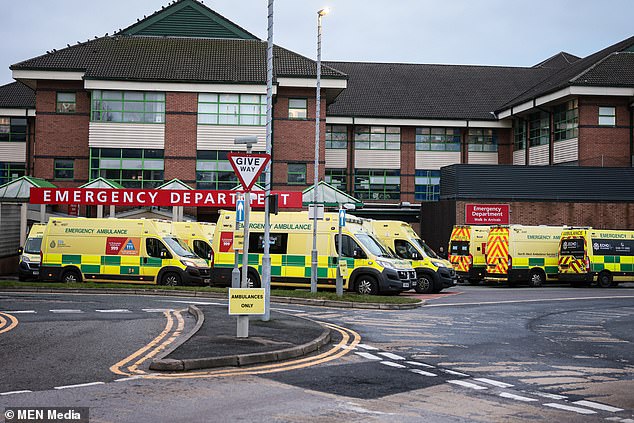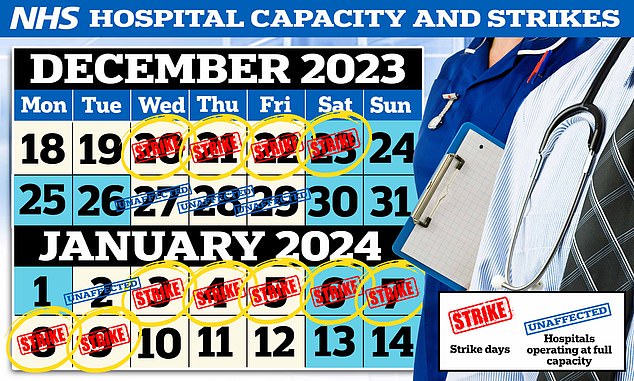‘Total chaos’ at major hospital’s A&E unit on Boxing Day as up to FIFTEEN ambulances are forced to queue outside
A major hospital's emergency room was in “total chaos” on Boxing Day, with “up to 15 ambulances” queuing outside to take sick patients, a paramedic said.
The paramedic, who asked not to be named, said he had not seen anything like the scene at Royal Bolton Hospital since the height of Covid.
A mother who took her son to the emergency department at Greater Manchester Hospital said she was advised to call for a taxi instead of an ambulance after calling the 111 service.
A major hospital's emergency room was in “total chaos” on Boxing Day, with “up to 15 ambulances” queuing outside to take sick patients, a paramedic said. The paramedic, who asked not to be named, said he had never seen anything like this at the Royal Bolton Hospital since the height of the coronavirus crisis.
The worrying scenes come after Health Minister Victoria Atkins called out bosses of hospitals with the longest delays in transferring patients from ambulances to A&E and told them to “substantiate their ideas”.
It also follows a three-day strike by trainee doctors before Christmas, which was feared to leave hospitals struggling to discharge patients before the holidays – with a record six more days of strike action planned for the new year.
The paramedic told how he arrived at lunchtime yesterday with a patient – describing the situation as 'total chaos'.
“This hasn't been like this for years since Covid,” he said.
“It was absolutely total chaos and I don't use the term lightly. The A&E staff is doing everything they can, but it's bad. There are ambulances everywhere.
'We arrived at the hospital with a patient and had to wait almost three and a half hours.
'There is no room for ambulance patients.

The worrying scenes at Royal Bolton Hospital come after Health Secretary Victoria Atkins called on bosses of hospitals with the longest delays for transferring patients from ambulances to A&E and told them to 'substantiate their ideas'
“We were all just sitting there and that means we can't go to other jobs.”
Twelve ambulances were parked outside the emergency room at 3pm on Boxing Day.
The waiting area was busy inside; about two-thirds of the seats were occupied.
A woman who brought her son said: 'We called 111 and they arranged a taxi for us instead of an ambulance and told us to come here straight away.
“My heart sank a little when I saw how busy it was, but within 15 minutes he was seen and another 15 minutes later he was in a cubicle, so he got through it pretty quickly.”
The paramedic said the situation appeared particularly bad at Royal Bolton Hospital, made worse by the closure of GP surgeries.
'We've been to Salford before and it was quiet. It just seems to be the Royal Bolton.”

Hospitals will only operate at full capacity for four weekdays until January 10. Only December 27, 28, 29 and January 2 are not affected by the impending chaos of the holidays and strikes until January 10.
On their website, hospital bosses said the emergency department was 'very busy' with waiting times of up to four hours, but stressed that 'the most seriously ill and injured patients will always be seen immediately'.
The hospital and the North West Ambulance Service have been contacted for comment.
Across England, 15 hospitals are responsible for almost half of all ambulance delays, and nationally one in eight patients now has to wait more than an hour outside A&E, according to analysis by The Times.
In 13 hospitals, the average wait time for patients transferred from ambulances to A&E this winter is now more than an hour, while in Plymouth patients wait four hours.
Trusts with the longest wait times were accused earlier this month of 'letting their communities down' by Ms Atkins, who told LBC the longest delays were 'simply unacceptable'.
It comes after ambulance bosses last week urged the NHS to treat patients in corridors.
Emergency vehicles have already had to queue for ten hours in front of hospitals this winter.
Figures from NHS England show that almost 29,000 hours were lost due to delays in the transfer of patients arriving at A&E by ambulance in the week ending December 17.
One in three patients had to wait longer than 30 minutes, while one in seven had to wait more than an hour. The target time is 15 minutes.
Daren Mochrie, chairman of the Association of Ambulance Chief Executives (AACE), said while it was “never ideal”, it would be better to admit patients into corridors rather than leave them in the back of an ambulance.
NHS bosses blamed a lack of space in hospitals, which was fueled by striking trainee doctors reducing the capacity to discharge patients and free up beds.
